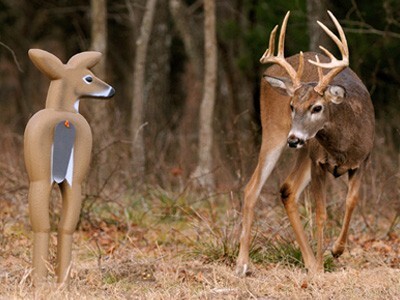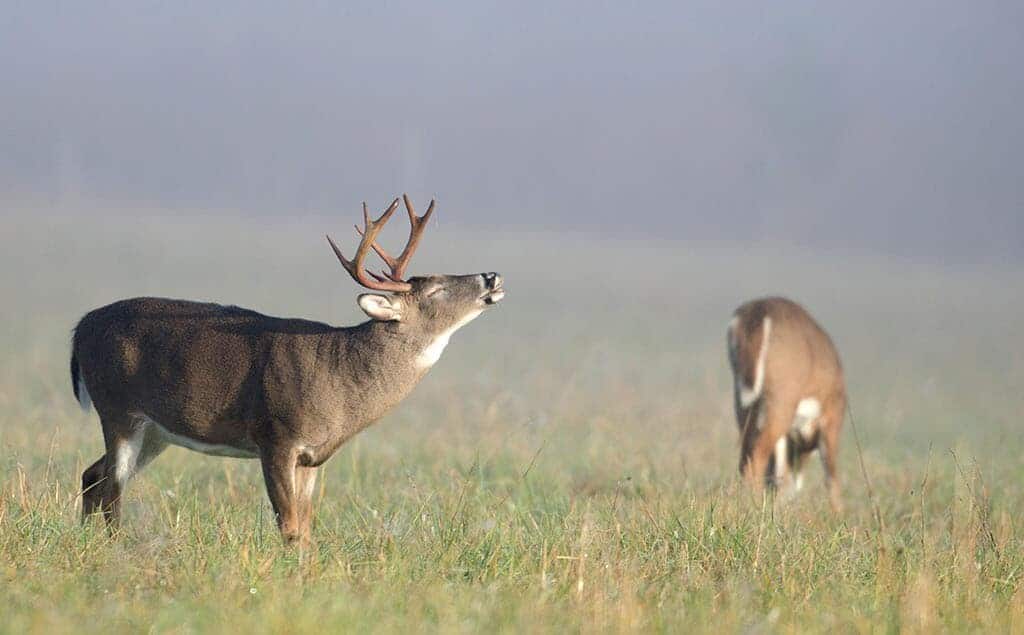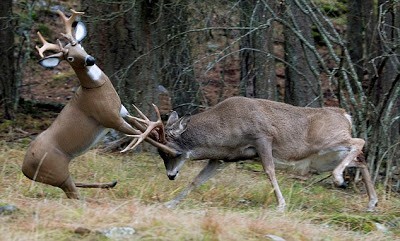Whitetail deer decoys are something that most hunters have probably not used all that much, if at all. When we think of whitetail hunting we typically think about hunting where the deer are or are going to be, and not particularly trying to get them to come into a decoy like a duck would. Although in some situations, using a deer decoy can be the trick you need to get that mature buck to come within bow range. Whitetail decoys are actually very versatile and are useful in more situations than you may initially think. Plus, understanding how to use decoys while deer hunting just adds one more tool to your arsenal, and helps you become a better hunter.
When You Should Use a Whitetail Deer Decoy
Although deer decoys can be an awesome tool, they do not work as intended during all times of the year. The goal of a deer decoy is to get a mature buck to come in and investigate it, either out of aggression towards a subdominant buck or to breed a new doe in estrus. Neither of these things happen all year round. Bucks are frequently seen in friendly bachelor groups made up of all classes of bucks during a large portion of the year, but they are only aggressive towards one another when the does start to go in estrus, aka the rut.
So, we want to use a deer decoy during the rut, but what specific situations or layouts call for the use of a decoy? Well truthfully, not every stand location, even fruitful ones, are going to be suitable for a deer decoy. Let’s go over what you need to do to set up a decoy, and if your stand location allows for these items below, then it is perfect for a whitetail decoy.

How to Set up a Deer Decoy
The number one most important thing about setting up a deer decoy is visibility. You may think at first that you want to set up a decoy on a well-traveled trail or close to a scrape line, but during the full rut, bucks do not care about any of that. They are running around everywhere, cutting across trails and not paying any attention to scrapes, they are only after one thing, does. So if they never see your decoy, they can never come into it.
You want to make sure that the decoy is out in the open as well. This means not putting it in a corner that is only visible from 180 degrees. Putting the decoy out in the open makes sure that if a buck does come into it, he feels safe because he has plenty of escape routes. If you limit his escape routes with natural barriers, he may not come in as close or may not come in at all.
This also gives you plenty of room for a shot. You never really know how a buck will react to a decoy. So giving them plenty of room, free of thick brush, makes sure that no matter how they react, you are still going to have a shot.
If you are a hunter that relies on wind direction, you should also consider which way it is blowing when you set up your decoy. If you can make deer walk upwind of you, that would be ideal and it gives you the highest success rate.
Lastly, you want to put your decoy within range of your stand. We are counting on an interaction between the buck and decoy, we are not trying to catch the buck on the way to the decoy. So ideally you want to place the decoy 20 yards away if you are bow hunting so that you can have a nice, easy shot when that mature buck comes in.
Deer & Deer Hunting have some great tips on the topic in their YouTube video you can watch here:
Should You Use a Buck or Doe Decoy?
At first, it may be a bit confusing as to which type of decoy you should use, although both buck and doe decoys work well in certain situations. If you want to harvest a large mature buck, you will want to use a buck decoy, or a combination buck and doe set up. Mature bucks normally know which deer should be in the area and if he sees a buck that he does not know, he is going to want to come over and establish his dominance. If he sees a buck he does not know which also has a doe close by, like a combination buck-doe decoy setup, then he may try to come and steal the doe away from the subdominant buck.
On the flip side, if you are interested in harvesting does or younger bucks, a buck decoy may not be the best for you. Younger bucks will be intimidated by most buck decoys and may avoid them. Now, I don’t know about you, but about 80% of the bucks I have harvested over my 21 years would have probably run and hidden from a buck decoy because they were a younger 1 to 2-year-old deer. The 3 to 4-year-old deer I have harvested may have put up a fight but you never know for sure. Plus during the rut, most does are going to be avoiding bucks so if you want to fill the freezer you may want to avoid using a buck decoy.
If you are trying to kill a doe or do not mind a chance at a younger buck, a doe decoy may do the trick. Young bucks and does will not be intimidated by a doe decoy and may come in to socialize with it. You can also use doe decoys earlier than buck decoys. This is because young bucks typically start to chase does earlier when most of them are not in estrus. When the rut goes in full swing they are often ran off by more mature bucks.
Using a Matching Call for Your Particular Deer Decoy

Besides a good set up, one of the most important things to do to your decoy is bring it to life. Letting out a few deer calls every now and then can be a huge game-changer. Especially when you see another buck. If you have a buck decoy out, let out a few grunts to get his attention. If he seems interested give him a few moments and let a few more out when he is not looking in your direction. If he is not interested, gradually make your grunts deeper and more aggressive, and if all else fails let out a snort wheeze. That will either bring him in or quickly let you know that he wants nothing to do with you or your decoy.
RELATED POST: 9 DEER CALLS EVERY HUNTER SHOULD KNOW
You can think of it a little like duck hunting, it would be odd for ducks to see other ducks on the pond but not hear them calling. If a buck sees another buck during their most vocal time of year, he will probably expect some sort of call from him. Plus if the buck feels like he is more dominant than your decoy, aggressive calls will only make him angrier and bring him in to set things straight.
Proper Deer Decoy Scent Control
Last but not least, you need to control how your decoy smells. When a deer does approach your decoy they are going to want to be social with it. This means they are going to smell all over it. If it smells like your house or truck, deer are definitely going to know that something is up.
It would be a little tough to put a decoy in the wash… so what are you supposed to do? In all seriousness, I would suggest not heavily handling your decoy unless your hands are washed, and to get the smell off it, you could spray it with scent eliminator spray. Then I would set it up outside and leave it there for about a week. I do the same thing with hunting blinds. Leaving them outside pulls all the human smells off of them and makes them smell like the surrounding area after a while.
When you are ready to take your decoy to the woods, I suggest putting it in the bed of your truck instead of the cab. You want to eliminate as much contact with human smell as possible.
Another important aspect of your decoys smell is the smells you purposely put on them. I suggest you put doe urine on the heads of either a buck or doe decoy. If you are using a buck decoy, you should then put dominant buck urine around its tarsal glands and its rear end. These are all the major areas other deer are going to smell your decoy, and you also want other deer to smell your decoy when they are downwind, so using strong scents improves your chances of pulling deer towards you.
Reading Whitetail Body Language as They Approach the Decoy
When a buck does come into your decoy, you are going to need to learn how to read his body language. Is he just curious, aggressive, or weary? Aggression is probably the easiest to read because he will be all puffed out and slow walking toward the decoy. They may even try to fight your decoy, which could cause problems.
As for all the other situations, you are really just going to have to learn from experience how whitetails act around each other. If you are a seasoned hunter you probably already know how deer socialize, but it is just one of those things that are difficult to put into words and comes better with experience.
What to Do if They Fight the Decoy

If a buck does try to fight your decoy, it is not a terrible thing. This means that he has come within range already and may present a shot. If he does make contact with it, he will probably knock it over and spook himself. If this is the case, you can bet that he is going to take a few bounds away, but he will stop for a few moments to look back and try to make sense of what happened. If you plan on shooting that buck, I suggest that you draw your bow back when he knocks over the decoy, when he stops to look back you will be ready to let one fly.
Types of Decoys and Their Advantages
When it comes to decoys there are two main types. You have 2D decoys, which are generally cheaper (still around $100), but they greatly limit the ability of your set up. If you set up your 2D decoy facing west to east, any deer that comes from the North or South will not be able to see it. They are also nearly useless if a deer wants to come into the decoy. They will quickly figure out it is 2D and will probably be spooked by it. You could set these up in such a way that you could shoot a buck before he reaches the decoy, but you are not going to shoot every deer that walks by you. So, if a doe or young buck makes their way to it, you may get busted.
However, all of the setup and strategy I talked about in this post revolved around 3D decoys. Cabelas actually has 3D whitetail decoys at a competitive price. You can get their buck decoy for $180 and their doe decoy for $140 at the time of this writing. These decoys are not cheap, but after they help you bag a mature buck, I am sure you will think they are definitely worth it.
Get Your Whitetail Decoy From Cabelas Here
Conclusion
Deer decoys are one of the best ways to get aggressive bucks to come in close. During the rut, set a decoy up close to your stand in an open area. You should also add plenty of scent to them and make a few grunt calls every now and then to bring your setup to life.
Whitetail decoys can be a useful tool, especially during the rut. Every set up is unique so the exact method you use may be different from what we talked about here, but that is okay. The beautiful thing about hunting is that there are no right answers. If you have never used a deer decoy, I think you should give it a solid try. You just might be surprised by the results!

